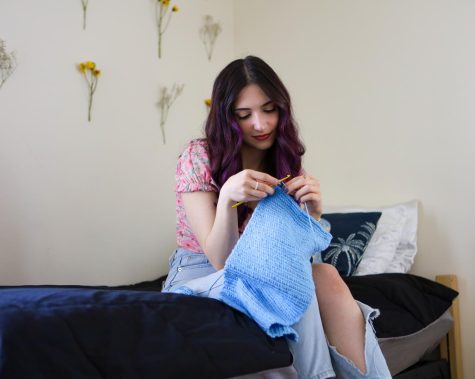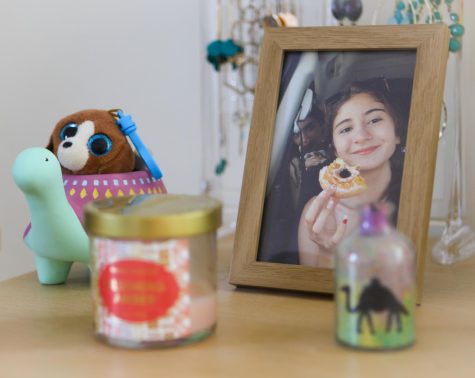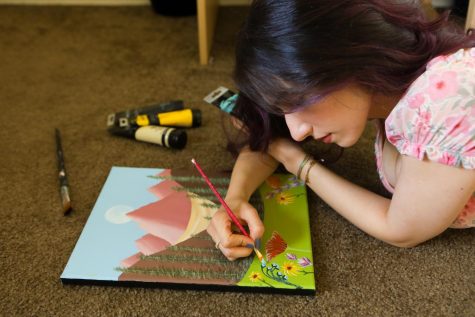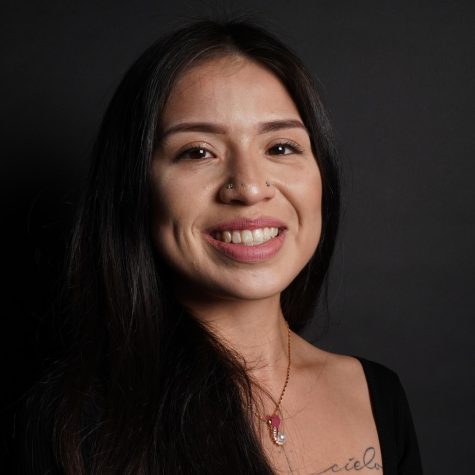Now What?
The struggle for independence in early adulthood.
Yara Jeries, a marketing major, stares up at the ceiling inside her dorm at University Park North, one of SF State’s student housing complexes, on Thursday, April 6, 2023. Jeries has lived in this dorm since Fall 2022 and shares it with 2 other people. (Gina Castro / Xpress Magazine)
Yara Jeries has deadlines to meet. No, not homework due dates or upcoming tests. Not credit card bills or car insurance payments. She has international student deadlines. If Jeries fails to find employment and housing upon graduating from SF State, she must move back to her home country, Jordan, and live with her parents. This means saying goodbye to her San Francisco friends, building her life in a different corner of the world and most likely, according to her, never living in the U.S. again. That wasn’t the plan.

“I think best case scenario would be to find my own place, still in San Francisco or somewhere close, finally have my car around, and then find a position in the company that I’m going for,” Jeries said. As of right now, the odds of any of that happening are low.
But Jeries isn’t alone in that struggle. According to research from the Pew Research Center, 52% of 18 to 29-year-olds in 2020 still lived in their family homes. College-graduate-aged adults live at home for longer now than in any previous generation. But the numbers make up just one aspect of the whole ordeal. Most college graduates today grew up with the same expectations that college graduates had 40 years ago. Most expect — or at least hope — to find a job, a house and, eventually, start a family. What effect does “failing” that expectation have on a young adult who lives in a culture that puts so much pressure on succeeding the first time? How do you find your independence while still living under your parents’ roof? Is the transition from college student to bonafide adult easy for anyone?
Jeries, a marketing major set to graduate this fall, moved from Saudi Arabia to San Francisco in August 2019. With the Coronavirus pandemic robbing Jeries of much of her social life at SF State, and her citizenship status restricting her from many different paid jobs, Jeries often speculates on where she might have studied or lived if not for her parents’ decision for her to attend SF State.
“Everything that I decided was pretty much based on where my family was going… It was really about them more than it was about me,” Jeries said.
Still, so close to her final semester at SF State, Jeries finds herself not wanting to return home just yet. Though eventually, she must return home at least long enough to “plan [her] next move,” if she fails to get a job and stay the maximum amount of time legally allowed would strike her self-esteem hard. After spending her whole college career out from under the direct supervision of her parents, going back to square one in her journey to independence seems unthinkable.

“It would be such a hit to my expectations,” Jeries said. “I really had this vision for where I wanted my life to go. And I feel like if I have to move back home to my home country, back with my parents, not have a job, I feel like that would really hit me hard mentally.”
Between the lack of independence and options at home and the prejudice and restrictions on immigrants in the U.S., Jeries thinks she might build a life in Europe, though that has its own drawbacks in terms of the job market there and its minimal opportunities, in Jeries’ opinion.
“Everywhere I think to go has this one factor that’s just a slap in the face,” Jerries said with a sigh.
However, not every college graduate faces the same struggles. In contrast to Jeries, Kylie Baker-Williams anxiously awaited her return home after she finished school. When she moved back to California from Kenyon College in Ohio, Baker-Williams appreciated living in her family home as much as she had when she’d left. Though her time away gave her space and independence, she had little trouble with the adjustment.
“I love home,” Baker-Williams said. “I loved having that independence and all that, but I hated not being able to see my family. I missed my family a lot.”
For Baker-Williams, the struggles she faced after college took two main forms. Initially, the change affected her body image. Baker-William’s hometown played a large role in her self-confidence, according to her.
“I think Marin is very — all the women and girls here are so conscious of their image,” Baker-Williams said. “Everyone’s so thin and small… I really spiraled with body image and my eating habits… I definitely didn’t feel that when I was at college.”
According to Baker–Williams, the culture where she lives in California focuses far more on appearance than in her college’s town, Gambier, Ohio.
As time went on since she’d come back home from school, another insecurity became prominent in her head as well. As a dedicated psychology student who took pride in her work, Baker-Williams missed the opportunity to excel that school provided. She remembers the impact that leaving that environment had on her confidence.
“I had a lot of my identity and self-esteem tied up in doing well in school, my GPA, my grades, being able to answer questions, things like that,” Baker-Williams explained. “So graduating, a couple months later, I was like, kind of spiral[ing.] I was like, ‘Oh, this whole thing has kind of been the center of who I am, like, I’m the kid that’s good in school.’ I don’t have that anymore.”
One psychotherapist, Satya Byock, who works exclusively with clients like Jeries and Baker-Williams, uses a unique term for those in this stage of their life: quarterlifer. In her book, Quarterlife: The Search for Self in Early Adulthood, Byock addresses the many struggles often faced by young adults and provides ways of thinking to help readers through them.
This period can prove so difficult for many because not only is it a complete shift from one distinct stage of life to another, but also because the way we measure adulthood differs from the way we have in the past, yet the expectation to reach it has remained just as rigid. Byock explains that the measure of maturity used to have a far more clear distinction than in recent generations.
“So historically, people would be leaving home to enter a marriage,” Byock said. “They were leaving their home primarily to enter a new home and create a family. So now we have this system that’s theoretically less segregated on some level by race and gender. You go to high school, maybe you go to college, community college, whatever. But there’s not a clear path from there into adulthood. It’s not like you’re setting up a separate home. So all of those things have to be figured out one by one by one. And I think it’s beautiful that we’ve made it so that adulthood is not directly tied to gender roles the way that it used to be, but we haven’t replaced it with anything that’s really clear.”
With no exact path to success, any deviation from the norms of the past feels like failing. Even though young adults increasingly reach typical milestones like moving out and starting a family later, due to their own choice or the economic state of the world, that blueprint for life remains prominent in their minds. And they still get judged for not following it.
“The cost of living has skyrocketed,” Byock said. “The cost of mortgages has skyrocketed, student loans have skyrocketed, and so, that sort of path from college into creating an independent life away from your parents has become significantly more difficult. And the idea that that’s like the fault of the young people or something, and they can’t grow up – like they’re having an ‘extended adolescence’ just drives me crazy.”

The phrase “extended adolescence” describes the period between adolescence and adulthood that seems to increase with every generation.
Byock rejects this term in defense of quarterlifers, explaining the importance of recognizing that quarterlife is a “stage of adulthood unto itself,” and that the struggles therein should be afforded the same attention as mid-life crises receive.
Byock explains that part of the struggle that quarterlifers face in finding a sense of identity and stability in adulthood comes from a “deeply internalized” shame from societal pressure and judgment. When children who grow up with a certain idea of what it means to be a successful adult based on past generations reach adulthood, the reality can be completely demoralizing.
“It should not be this difficult to become a happy and functional adult,” Byock said. “But there’s so much pressure on young people to both succeed and to ‘adult’ and so much going against them that it feels like a constant pressure that’s almost impossible to get out of.”
This is not to say that checking the typical boxes of adulthood is the only way for one to reach a state of independence and maturity. Byock explains that young adults like Jeries and Baker-Williams can change the dynamics they have with their home lives and the relationships they have with themselves through conscious and loving work.
“You might be living at home and really be able for the first time to have conversations with your folks, or whomever you live with, as an adult,” Byock said. “To work out boundaries and to work out old patterns and to hear old stories and to develop a new kind of friendship.”
Whatever your chosen method of independence, there isn’t really a wrong answer. The question then becomes, how can graduates train themselves out of the seemingly inevitable shame that comes with maturing? Alternatively, as Byock asked:
“What is actually a path into independent adult life that doesn’t feel crippling?”

Gina Castro (she/her) is a staff photographer for Golden Gate Xpress. She is a Mexican-American photojournalism major and Africana studies minor. She...



